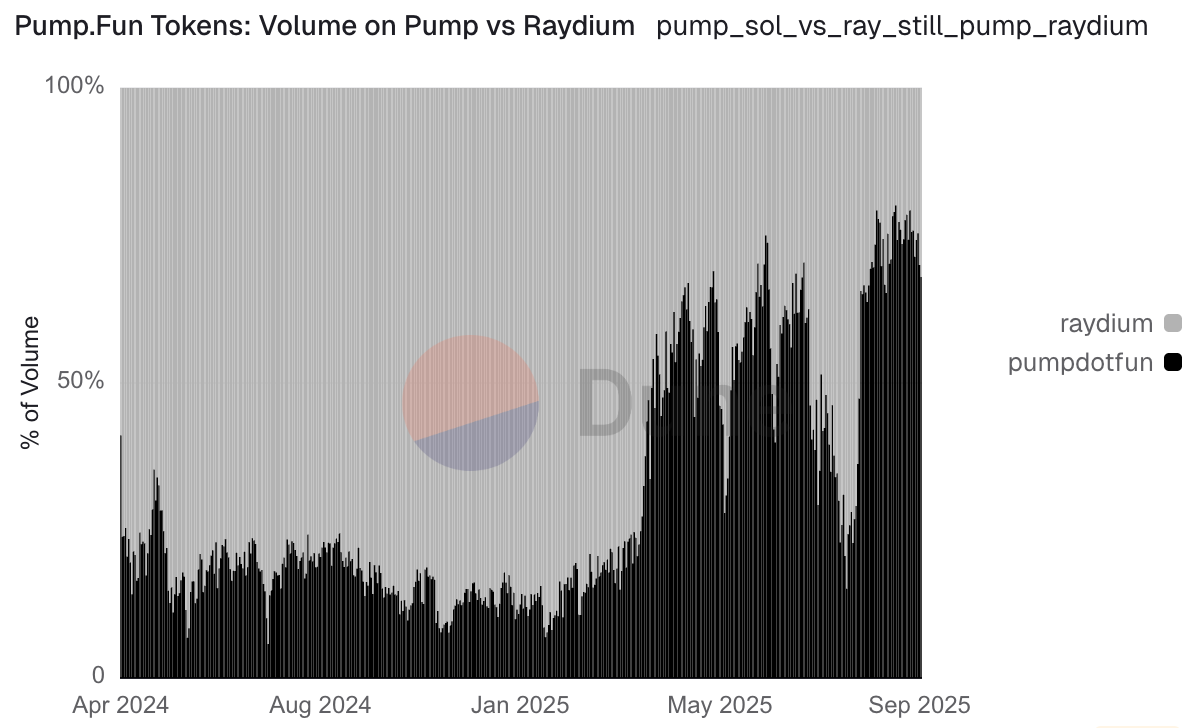Lessons from pump.fun
Intro
At first glance, Pump.fun looks like a chaotic memecoin launchpad that just got lucky riding the latest crypto wave. For a while, we thought so too. But behind the memes is one of the most successful projects in crypto today.
In less than two years, Pump.fun has gone from a scrappy launchpad to one of the most dominant trading platforms in the space – generating over $70 billion in trading volume and $700 million in revenue in the past year alone. It’s now the top DEX by revenue, surpassing platforms like Uniswap and Raydium.
Even if you don’t believe in memecoins, how Pump built and scaled its product is hard to ignore. It didn’t grow through hype, splashy airdrops, or unsustainable token incentives. It grew by nailing the same fundamentals that define many great startups in their early days: doing things that don’t scale, iterating fast, and aligning incentives so growth compounds on its own.
Doing things that don’t scale
Almost every great company has started out by manually recruiting its first users.
“The most common unscalable thing founders have to do at the start is to recruit users manually. You can’t wait for users to come to you. You have to go out and get them.” - Paul Graham
That kind of unscalable hustle is a hallmark of iconic startups. Airbnb’s founders famously went door-to-door in New York City, photographing apartments and coaching hosts on how to improve their listings. Doordash’s early team delivered food themselves at first, using spreadsheets to coordinate drivers and routes.
Pump.fun was no different. The team didn’t just wait for traders to stumble onto their site – they went out of their way to put the product in front of other people. Alon, one of Pump’s cofounders, said he personally sent more than 3,000 cold DMs to potential users alone (example below).

In short, Pump.fun wasn’t a “if you build it, they will come” phenomena. The first thousand users were pulled in, one by one, through relentless outreach. And the benefit went far beyond early traction. Each conversation gave the team a sharper sense of what users cared about, creating a feedback loop that not only fueled growth but shaped every product decision that followed.
Iterate quickly and follow the signal
The best startups don’t just listen to the market. They act on it. Every behavior, complaint, or unexpected use case is a signal worth building around.
Take Slack for example. The team originally set out to build a multiplayer game called Glitch but noticed their internal chat tool was getting more traction than the game itself. Instead of forcing the original vision, they spun the chat feature into its own product, which went on to redefine workplace communication.
Pump followed a similar path. From the start, the team prioritized fast iteration over long-term planning. They launched with a bare-bones MVP to validate their idea, killed experiments that didn’t work (like an early deployment on Blast), and doubled down on Solana just as memecoin activity began to take off. That iteration put Pump in the right place at the right time.
As the number of new tokens exploded, discovery quickly became overwhelming. Pump caught this early and responded with “featured” sorting to surface higher-quality projects, making the platform much easier to navigate.
When higher-quality tokens started driving most of the trading volume, Pump moved quickly to capture that value. Rather than letting it flow to a third-party exchange like Raydium, they launched PumpSwap, their own exchange, which allowed them to internalize order flow and generate an additional ~$40 million in revenue since launch.

Pump was equally quick to adapt to emergent user behavior. As creators started livestreaming token launches to generate attention/hype/volumes, the team leaned in and made it a native feature. Livestreaming is now central to Pump’s vision – proof that the market often shows you the right path if you’re willing to listen.
Importantly, none of these changes came from a multi-year roadmap. They came from listening to users, iterating quickly, and doubling down on what worked. That’s how Pump turned a scrappy launchpad into one of the most popular crypto products.
Align incentives
Once you reach product market fit, the next challenge is making sure growth scales with your supply side. The best marketplaces do this by designing systems where users’ incentives naturally drive the platform’s success.
YouTube is the canonical example. Its Partner Program gives creators a direct share of ad revenue, turning every creator into a marketing engine for the platform. The more viewers they attract, the more money both they – and YouTube – earn. When the supply side’s upside is structurally tied to the platform’s, distribution becomes self-sustaining.
That’s the opposite of paying influencers, spending millions on ad campaigns, or bribing users with airdrops. Those tactics can buy short-term attention, but they rarely compound. When incentives are aligned, growth becomes organic and durable.
Pump applied the same principle. The team didn’t spend money on marketing. Instead, they built a model where creators do the distribution themselves. When a token graduates to PumpSwap, its creator earns a share of trading fees, giving them real skin in the game and a direct stake in the platform’s success.
That simple mechanic created a reflexive growth loop. Thousands of creators began competing to make their tokens succeed, promoting them across social channels and experimenting with trending memes and narratives. The result is a platform where marketing and growth are entirely community-driven.
Conclusion
Building a successful marketplace is notoriously hard. There’s no easy playbook that guarantees success. But founders can dramatically improve their odds by staying close to their core users and building alongside them.
Even in a seemingly chaotic space like memecoins, Pump proved that listening to users, adapting to their behavior, and aligning your success with theirs can turn a contrarian idea into one of the fastest growing crypto products.


